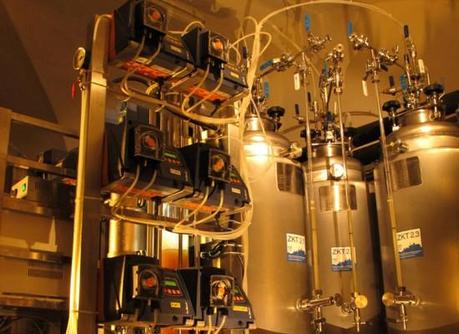
The pilot plant for new the fermentation process (Picture: K. Auffermann-Müller/TUM)
The beer is going green, and it has nothing to do with St. Patrick’s Day—a group of scientists from the Technical University of Munich (Germany) have developed a new non-stop fermentation process that takes place in stages over a number of interconnected tanks. The tank system can be operated continuously over a period of several months, which leads to an energy reduction. The new method also promises significant resource efficiency gains.
Fermentation and lagering are the most time-consuming stages in the brewing process. In these production steps the beer develops its characteristic flavors and aromas. “The taste and quality of the beer depend to a large extent on the type of yeast used, and the applied fermentation process,” explains Konrad Müller-Auffermann of the Research Center Weihenstephan for Brewing and Food Quality.
Breweries normally use large, cylindroconical, stainless steel tanks (CCTs) for fermentation. These tanks have only one inlet and outlet at their base for filling and discharging the beer and yeast. Once fermentation and lagering have been completed, the breweries release the carbon dioxide that has built up in the tanks and clean them thoroughly—a process that usually takes several hours. Subsequently the tanks can be refilled with the next batch.
Therefore the tanks cannot be used for production during filling, emptying and cleaning. In order to eliminate these downtime, a TUM scientist has developed a new process that allows continuous fermentations in a number of interconnected tanks. “We simply equip the existing tanks with a central pipe, with open bottom,” says Müller-Auffermann. “This enables the combination of tanks in order to create a reaction cascade.”
The advantages of continuous operation
With this new process, yeast and other sedimented substances can be separated into fractions and re-used if required. Müller-Auffermann explains: “By installing a downward-facing pipe, we created two reaction zones in each tank. Now, unlike the conventional system, the brewers can fill and empty the tanks continuously from the top part of the tanks. The bottom connection of the tank can hence be used to discharge yeast cells and other particles.”
Continuous operation makes the fermentation plant more efficient. “This new method reduces the incidence of energy peaks, so that breweries will be able to save on electricity. In addition, less beer will be lost—and breweries can save water and cleaning detergents,” says Müller-Auffermann.
The process and system, for which TUM has submitted a patent application, is running successfully on a small scale at the Research Center Weihenstephan. Hence, the brewing industry is already considering the application of this efficient and environmentally friendly concept for industrial-scale operations in the near future.
Old dream—New solution
Brewers have been juggling with the dream of turning the classical batch fermentation into a continuous process for over 100 years. In all this time, however, no one has managed to develop a widely applied industrial concept. Dr. Friedrich Jacob, Director of the Research Center Weihenstephan for Brewing and Food Quality, explains why: “Beer is a highly complex product with hundreds of different components. Even very minor changes in technology can result in too much or too little of a particular substance forming—which may potentially impair the flavor of the beer.”
“When developing this new process and technology, the simplicity was always in the main focus,” adds Müller-Auffermann. “Since the yeast plays a decisive role in the quality of the beer, we handle this sensitive organism nearly identically, compared to the traditional process. That is the key to a consistently good product.”

